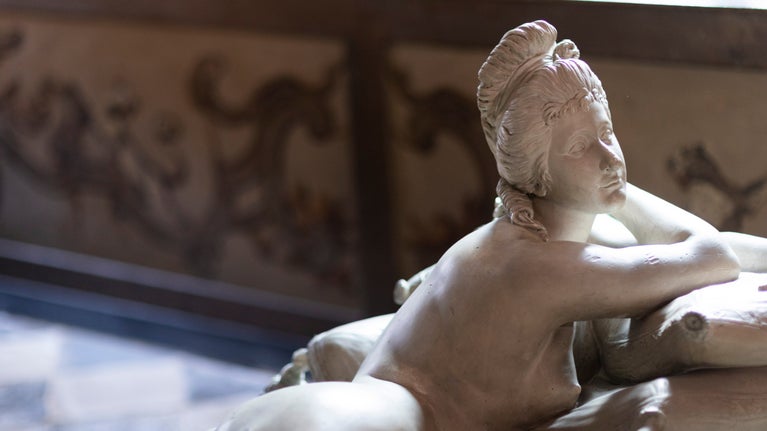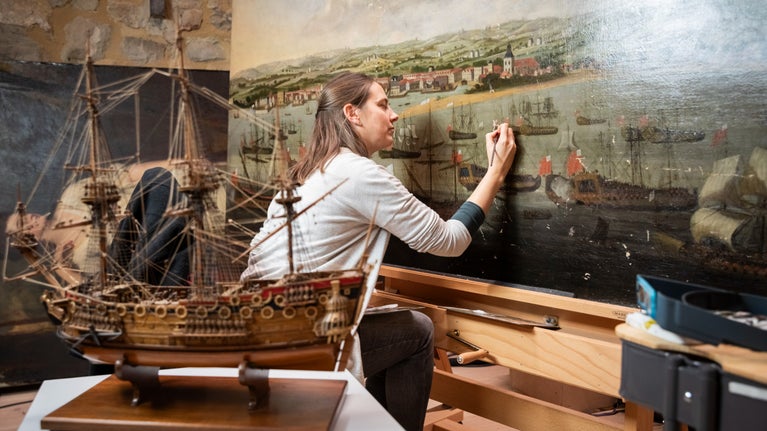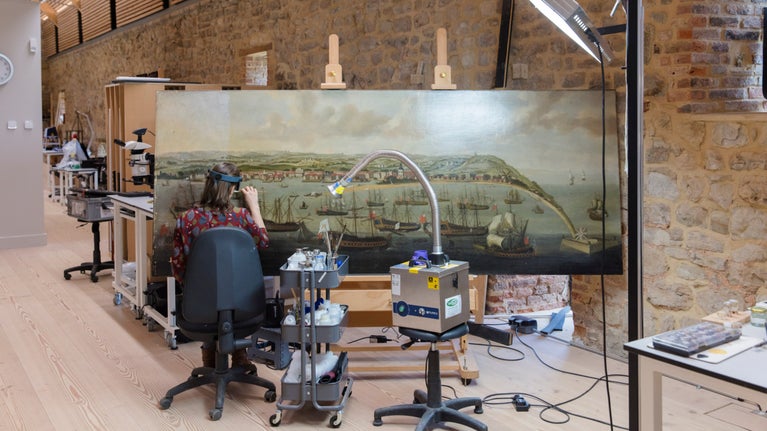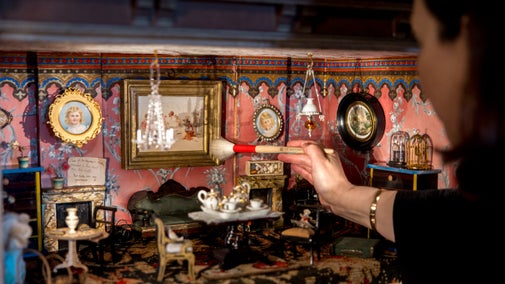
Watch the series
You can watch Hidden Treasures of the National Trust on iPlayer, series three is available from 16 May. Catch up on episodes you may have missed or see the first two series again.

We’re one of the places featured in series three of BBC Two’s Hidden Treasures of the National Trust. The show goes behind the scenes to hear from the experts who look after treasured objects, including Dyrham Park's significant and newly conserved painting of the port of Bridgetown, Barbados, in episode three.
Dyrham Park was one of the locations featured in episode three alongside Kedleston Hall. The episode aired on Friday 30 May and gives a taste of conservation work, on collection items in the house and by the hardworking dry stone wall team.
You can watch the six-part series every Friday at 9pm on BBC Two, starting from Friday 16 May or catch up on any episodes you miss on BBC iPlayer.

The Dyrham Park episode explores a panoramic painting newly acquired by the National Trust and thought to be one of the earliest painted depictions of the port of Bridgetown, Barbados. The painting had belonged to William Blathwayt, the leading colonial official of the late 17th century and owner of Dyrham Park. It left the house in the 1950s with the last Blathwayt owners of Dyrham Park and was acquired by the National Trust in 2022.
The painting has been undergoing extensive work at National Trust’s Royal Oak Foundation Conservation Studio in Knole in Kent since March 2024 and came back to Dyrham Park in early June 2025.
Thought to be by an Anglo-Dutch or Anglo-Flemish artist and one of only three paintings of 17th-century Barbados known to exist, ‘A View of the Port of Bridgetown, Barbados, with Extensive Shipping’ has also found itself at the centre of a research collaboration between historians from Yale Center for British Art, Barbados Museum and Historical Society and the National Trust.
The collaboration has brought together experts from different disciplines across the globe. Expert historians specialising in Barbados, maps, military, maritime and art have all contributed to create a deeper understanding of what is being portrayed in this rare and significant painting.
A Spanish ship sits alongside many English vessels, depicting what could be an event of significance, as ships fire salutes and trumpeters fanfare. It may show the 1690s when England and Spain were allied against the French during the Nine Years’ War (1688-97). Research to uncover more continues.
Barbados was then the wealthiest English colony in the Caribbean, and a key port of call on transatlantic routes. Ships arrived with enslaved African people to work on the plantations and departed with sugar for sale in Europe. Wind-powered cane mills, warehouses, wharves, and ships are shown in the painting; enslaved Africans are absent from the scene.
Almost 500 hours were spent on the painting at the conservation studio. The painting was cleaned to remove a yellowed varnish, along with a substantial amount of old restoration paint which obscured around 40-50% of the work. Tiny brushes were used in highly skilled precision work to inpaint damaged areas whilst leaving visible as much of the original as possible. A maritime historian was consulted to help accurately recreate the ships’ rigging. The painting was also sent to the Courtauld Institute of Art for technical analysis and an X-ray to look at its composition.
From Friday 6 June, the painting will be on show on an easel in Dyrham Park house’s Slop’t Parlour, allowing visitors to get close and see the fine details.
The programme also features fine 17th-century Flemish wall tapestries from the collection that were conserved at the National Trust Textile Conservation Studio in Norfolk followed by specialist wet cleaning in Belgium. Hanging in the house’s Tapestry Bedchamber, the tapestries are one of only two sets of their kind in the UK depicting the fountains and parterres of the famous gardens at Enghien near Brussels.
Dry stone wall volunteers who play a vital role in the 270-acre South Gloucestershire site’s outdoor team, also feature in the hour-long episode.

You can watch Hidden Treasures of the National Trust on iPlayer, series three is available from 16 May. Catch up on episodes you may have missed or see the first two series again.
Follow our conservators, curators and volunteers at work and get closer to the objects they care for in the BBC's Hidden Treasures of the National Trust.

The main phases of conservation and decorative work in the house at Dyrham Park are now complete and you can explore beautifully presented rooms, delve into the house's history and discover what it was like to live in the 17th century.

There is history of occupation at Dyrham Park from ancient times. Find out about the people and families who have added their stories to Dyrham Park.

Dyrham Park has a long history with deep connections to colonialism and the British Empire, all of which is reflected through the history of three prominent families.

The latest exhibition explores the historical events and characters of the late 17th century and how they influenced William Blathwayt while he created the Dyrham Park we know today.
